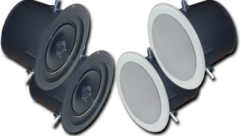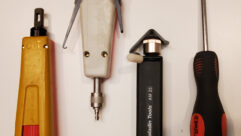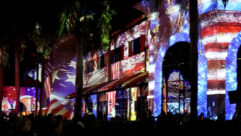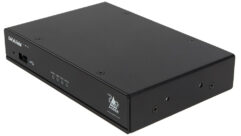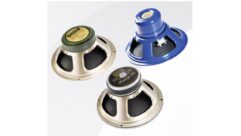HEAVY METAL, PART 1
Jun 1, 2002 12:00 PM,
PETER H. PUTMAN, CTS
OVER THE PAST COUPLE OF YEARS, I HAVE RUN numerous tests of indoor and outdoor DTV reception. Those tests have taken place in apartments, basements, attics, on roofs, on a nearby hilltop and even on the rear deck of my house.
I’ve used numerous first-generation and second-generation 8VSB tuners, preamps and all kinds of test equipment to see just how difficult over-the-air reception really is.
Regular readers will recall that I had success in a surprising number of locations, particularly with newer tuners such as Samsung’s SIR-T150 and even with PC card tuners made by accessDTV and Hauppauge Electronics. My explorations yielded a stack of gain tables and hundreds of spectrum analyzer plots that occupy several CD-ROMs.
Until recently, I had never done a simultaneous side-by-side test of all the antennas I had in my stockpile. The task seemed too daunting, but repeated requests for an all-inclusive table of antenna performance from readers and from members of various online forums finally did it. Over a period of two days, I dragged every antenna I could find out of my attic, basement, office and studio, set them up on my backyard test range and ran comparative gain tests for each and every one.
On the third day, I dragged a bunch of antennas into my studio and ran indoor VHF/UHF performance tests, including reception of the seven available DTV signals in the area. Although not as complex as the outdoor tests, they were nearly as time-consuming — but the tests yielded reams of data.
This month’s column will go into the outdoor performance tests, and I’ll discuss the indoor antennas in the July 2002 issue.
OUTDOOR TESTING
tuner performance has improved geometrically. Samsung, Zenith and Sony are all coming out with new third-generation set-top receivers this summer and fall. Samsung is bringing three new models to market: the SIR-T151, an economy OTA-only tuner; the SIR-T160 combo OTA/DirecTV box (enabled with HDCP-DVI); and the SIR-T165, another OTA-only design with IEEE-1394 output for interfacing with JVC’s HM-DH30000U D-VHS recorder/player.
Meanwhile, Linx Electronics, a company consisting of ex-Zenith employees, has developed an even better 8VSB receiver system that practically eliminates multipath problems. Dubbed “Casper” (because it makes ghosts friendly), this receiver was demonstrated at NAB 2002 and underwent rigorous tests at the Communications Research Center Canada to prove its worthiness. (The full report is available at linxelectronics.com). I hope to have more information about this new receiver as well as samples of the Samsung tuners to show at my seminar about DTV Reception and Display at InfoComm 2002.
Despite the fact that 8VSB receivers are getting progressively better, you still need an antenna of some kind to pick up the signals. It still makes sense to use an antenna with enough gain at the desired frequencies, as well as an appropriate pattern to handle multipath and put the gain in the direction you need it. For my outdoor tests, I set up a battery of test equipment. A 15-foot mast was used with a tripod support anchored to the rear of the deck. This particular location has a combination of medium to high signal levels and medium to high multipath, pretty typical of the average suburban or city location.
A 50-foot section of Radio Shack RG-6 was used for each antenna, and it fed the Samsung SIR-T150 tuner as well as a spectrum analyzer through an RF loop. A Sadelco Mini-Max 800 signal strength meter was also used to peak the antenna for maximum signal on each channel. All of the outdoor antennas were tested on every available VHF and UHF analog and digital channel, even if they were VHF-only or UHF-only designs. Even though a given antenna may not have gain at specific frequencies, it might still work if the signal levels are strong enough. That could advantageous when trying to keep antenna profiles small or disguised.
I took JPEG photos of some of the waveforms, particularly when I had better-than-expected results with reception. That happened with some of the combo VHF-UHF antennas and high-band UHF DTV signals on channels 62, 64 and 67. All outdoor antennas were tested without external preamps; powered antennas were tested while powered up. Antennas that had a selectable gain switch (internal amp On or Off) were tested in both modes.
RESULT TABLES
all measurements were taken in dBmV (subtract 47 to get the dBm reading) from the Sadleco Mini-Max. This meter has a lower sensitivity limit of -20dBmV (about -13.2 dBmV in digital mode), so any signal that fell below that threshold was simply logged as <-20 (analog), or <-13.2 (digital). (These are denoted in the tables by “a*” or “b*.”)
Analog and digital signal readings for each band are given, above or below zero dBmV. Analog and digital signals that fell below the sensitivity of the meter are noted with a simple asterisk. Note that I couldn’t gain any data about VHF DTV reception, simply because there aren’t any VHF DTV allocations in my area.
In addition to tables for analog and digital signal strength, you’ll also find a fourth table that shows carrier-to-noise measurements. An accurate C/N measurement is not easy to do without more sophisticated test equipment than I had on hand. Plus, there’s a correction factor to be added when measuring digital TV signals on a conventional spectrum analyzer. (I covered this in earlier columns about indoor reception in December 2001, June 2001, and June 2000.) The numbers in the C/N table are not perfect measurements, but they are pretty close. In that table (on page 26), a number without notation indicates that the signal locked up the Samsung tuner and held it for at least 3 minutes without dropout. Note (1) means moderately severe multipath was seen on the waveform, but the signal still locked up the SIR-T150 for at least three minutes. Entries with a dagger indicate that reception of that DTV channel was intermittent, and an entry of “DNR” means that the tuner did not lock up on the signal. Again, a simple asterisk indicates that the signal fell below the sensitivity of the meter.
- VHF Analog. There were no big surprises in these results. In general, the larger antennas had the most gain across the board, but the smaller, economical Radio Shack VU-75XR didn’t give up much to the two Channel Master log periodic antennas. The Terk TV55 was severely hampered by having its internal amplifier switched off, except when receiving channel 6.Among the amplified models, the CM 3010 StealthTenna was the clear winner on channels 3 and 10. The TV55 worked best on channel 6, and the CM 3000A SmarTenna had a bit more gain on channel 12. None of the UHF antennas amounted to much on any VHF channel with the exception of channel 10 on the Channel Master 3028 8-bay bow tie. (That might not be a good thing from a VHF interference standpoint.)
- UHF Analog. Results were all over the place on this band. Among the combo antennas, the best performer up to channel 50 was the Channel Master 3020 fringe antenna, but the smaller RS VU-75XR and Terk TV35 gave a better accounting on channels 57 and 69. Once again, the TV-55 unamplified exhibited unusual gain characteristics, with low gain on channels 17 and 29 and a surprisingly good performance on channel 69.Among the amplified antennas, the CM 3010 was a better choice up to channel 39, with the amplified TV55 doing well on channels 48 and 57 and the 3010 topped the group on channel 69. The UHF-only antennas held up across the board, with signal strength measurements pretty much linked to antenna size. (Yes, I did stick a Silver Sensor atop the 15-foot mast for this test.) Channel Master’s Model 3023 long UHF yagi took first place on each channel except 69, where it was edged out by the Radio Shack U120R long yagi.
- UHF DTV. A quick look at this table will show you that DTV signals as a whole aren’t too strong at my location, but they don’t need to be because the ATSC standard calls for a Gaussian (hypothetical) C/N ratio of 15.3 dB for successful reception of 8VSB signals. In reality, we live in a Rayleigh environment with lots of signal reflection and refraction, and I have found that somewhat higher C/N levels are needed.Keep in mind that these are measurements of signal level, not whether a given antenna was able to receive the signal. (I’ll cover those notes in Table 4.) For reference purposes, the reference points are above for the effective radiated power (EIRP) levels for each digital TV station received.Most of the combo VHF/UHF antennas worked about as well as a dummy load in terms of gain. CM’s 3020 and the RS VU-75XR were good choices for channel 26, and both managed to make the signal strength meter jump on channels 62 and 64. Among the amplified antennas, the CM3010 and Terk TV55 turned in slightly better numbers than the CM 3000A on channels 26 and 64, with the 3000A winning out on channel 42.The UHF antennas held their own. Once again, the CM 3023 was a clear winner on all DTV channels except 64, where the CM 3021 4-bay bow tie edged it out. Considering the UHF band covers about 500 MHz of spectrum, it’s hard to find one antenna that works well at all these frequencies, but the CM 3022 suburban UHF yagi also did well.
- UHF DTV C/N Ratios. For these tests, I verified reception with the Samsung SIR-T150 feeding a small 20-inch TV set to check for video and audio dropout. Among the VHF/UHF combo antennas, the CM 3020 held up best on channels 26 through 55, with the meek and mild RS VU-75XR edging it out for channels 62 and 64. Only the Terk TV35 registered a signal on channel 67, and though it was racked with multipath, WCAU’s digital signal was rock-steady nonetheless.
Competition was fierce among the amplified antennas. Both the CM3010 and Terk TV55 held channel 26 nicely, despite severe multipath. The TV55 was a bit better on channel 42, and the CM 3010 was again on top with channels 46, 55 and 62. Both antennas kept WPVI-DT’s 720p signal cooking on channel 64 though the waveform was noticeably cleaner on the CM 3010. None of the antennas could pull in channel 67, however.
The UHF tests were very close in all respects. Waveforms were clean on all signals — no significant multipath was seen in any case. Radio Shack’s U120R took top honors on channel 26, edging out the CM 3023, which did best on channel 42. The CM 3028 held up nicely on channel 46, and there was a four-way tie on channel 55 between the two CM yagis, the RS U120R and my own homebrew UHF antenna. The CM 3023 pretty much handled the rest of the signals, except on channel 64, where it was bested by the CM 3021 and 3022.
CONCLUSIONS
my tests are by no means as accurate as those taken on a test range under optimal conditions. Rather, the results show you how given antenna models compared with each other under identical conditions with a baseline tuner and measurement equipment. As Hugh Downs used to say, “Actual results may vary.”
Given the improvements in sensitivity and multipath equalization in successive generations of DTV tuners — and the ghost-moderating improvements to the Linx DTV receiver system — it appears that antenna gain will become the most important factor for outdoor DTV reception (along with low noise figure and signal distortion in amplified antennas).
Next month, I’ll continue my “heavy metal” tests with a grouping of small indoor antenna designs for VHF and UHF. Stay tuned!
Peter H. Putman owns PHP Communications, Doylestown, Penn. He is the author of The Toastmasters Guide to Audio/Visual Presentations. Putman is also a regular columnist in S&VC and in other magazines for the video and A/V industries.
Outdoor Antenna Performance
All measurements in dBmV
* Signal fell below the sensitivity of the meter
(a*) Reading fell below analog threshold of -20 Dbmv
(b*) Reading fell below digital threshold of -13.2 Dbmv
DTV Signal Strengths at Site
KYW-26 = 787 kW
WTXF-42 = 319 kW
WFMZ-46 = 12 kW
WHYY-55 = 87 kW
WLVT-62 = 48 kW
WPVI-64 = 500 kW
WCAU-67 = 112 kW


